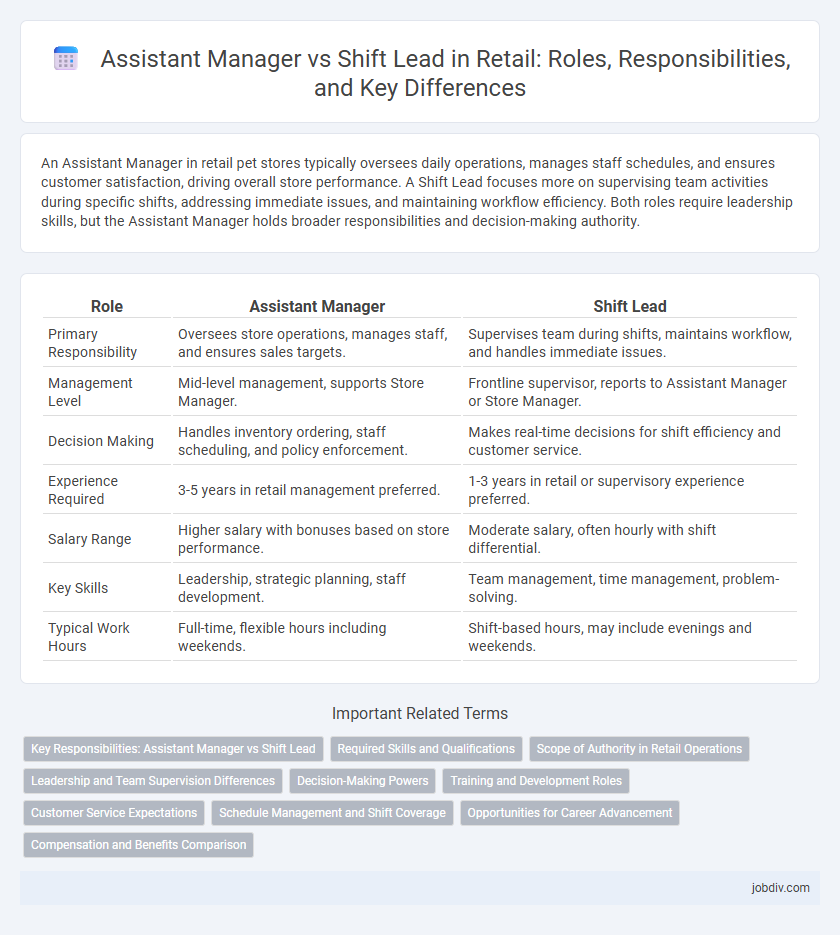An Assistant Manager in retail pet stores typically oversees daily operations, manages staff schedules, and ensures customer satisfaction, driving overall store performance. A Shift Lead focuses more on supervising team activities during specific shifts, addressing immediate issues, and maintaining workflow efficiency. Both roles require leadership skills, but the Assistant Manager holds broader responsibilities and decision-making authority.
Table of Comparison
| Role | Assistant Manager | Shift Lead |
|---|---|---|
| Primary Responsibility | Oversees store operations, manages staff, and ensures sales targets. | Supervises team during shifts, maintains workflow, and handles immediate issues. |
| Management Level | Mid-level management, supports Store Manager. | Frontline supervisor, reports to Assistant Manager or Store Manager. |
| Decision Making | Handles inventory ordering, staff scheduling, and policy enforcement. | Makes real-time decisions for shift efficiency and customer service. |
| Experience Required | 3-5 years in retail management preferred. | 1-3 years in retail or supervisory experience preferred. |
| Salary Range | Higher salary with bonuses based on store performance. | Moderate salary, often hourly with shift differential. |
| Key Skills | Leadership, strategic planning, staff development. | Team management, time management, problem-solving. |
| Typical Work Hours | Full-time, flexible hours including weekends. | Shift-based hours, may include evenings and weekends. |
Key Responsibilities: Assistant Manager vs Shift Lead
Assistant Managers oversee daily store operations, manage staff schedules, and handle inventory control to ensure efficient workflow and sales targets are met. Shift Leads coordinate employee tasks during shifts, maintain customer service standards, and resolve immediate operational issues on the floor. Both roles involve team leadership and customer interaction but differ in scope, with Assistant Managers holding broader managerial duties and Shift Leads focusing on shift-specific execution.
Required Skills and Qualifications
An Assistant Manager in retail typically requires advanced leadership skills, employee training experience, and proficiency in inventory management, along with a bachelor's degree in business or a related field. A Shift Lead focuses on strong communication, team coordination, and problem-solving abilities, often necessitating prior experience in frontline retail roles but generally no formal degree. Both positions demand customer service expertise and a solid understanding of retail operations to ensure efficient store performance.
Scope of Authority in Retail Operations
Assistant Managers in retail operations oversee multiple departments, manage inventory control, and implement store-wide policies, ensuring overall operational efficiency. Shift Leads focus on supervising front-line employees during specific shifts, handling immediate customer service issues, and maintaining daily workflow. The Assistant Manager holds broader decision-making authority, while the Shift Lead's scope is limited to shift-level team coordination and task execution.
Leadership and Team Supervision Differences
Assistant Managers oversee broader store operations, including staff scheduling, inventory management, and customer service strategies, while Shift Leads primarily focus on real-time team supervision during their shifts. Leadership for Assistant Managers involves strategic decision-making, coaching multiple teams, and supporting store management goals, whereas Shift Leads provide direct task delegation, motivation, and immediate problem-solving on the floor. The Assistant Manager role requires a higher level of accountability and leadership development, managing both employee performance and operational efficiency across shifts.
Decision-Making Powers
Assistant Managers possess broader decision-making powers, including staffing, budgeting, and conflict resolution, enabling them to oversee overall store operations. Shift Leads primarily focus on real-time operational decisions during their shifts, such as managing employee tasks and customer service issues. The Assistant Manager's authority typically surpasses that of the Shift Lead, empowering strategic planning and policy enforcement in retail environments.
Training and Development Roles
Assistant Managers typically oversee comprehensive training programs, ensuring staff develop both customer service and operational skills, while Shift Leads focus on on-the-floor coaching and immediate problem-solving to enhance team performance during shifts. Assistant Managers often design development strategies, track employee progress, and facilitate workshops that align with store goals. Shift Leads support continuous learning by mentoring team members in real-time, promoting adherence to store policies and improving shift productivity.
Customer Service Expectations
Assistant Managers are expected to oversee customer service strategies, ensuring consistent delivery of high-quality experiences across all shifts while resolving complex customer issues. Shift Leads directly manage frontline employees during specific shifts, focusing on real-time problem-solving and maintaining service standards to meet customer expectations. Both roles require strong communication skills, but Assistant Managers emphasize strategic customer satisfaction improvements, whereas Shift Leads prioritize operational execution.
Schedule Management and Shift Coverage
Assistant Managers oversee schedule management by creating and adjusting employee shifts to ensure optimal coverage during peak hours and special promotions. Shift Leads focus on executing these schedules on the floor, addressing real-time coverage issues, and reallocating staff as needed to maintain operational efficiency. Both roles collaborate closely to minimize understaffing and support seamless retail operations.
Opportunities for Career Advancement
Assistant Managers in retail often have broader responsibilities, including staff management, inventory control, and financial reporting, which position them well for senior management roles. Shift Leads typically focus on supervising team members during specific shifts, providing valuable leadership experience that can lead to promotions to Assistant Manager positions. Career advancement opportunities increase significantly for Assistant Managers due to their involvement in strategic decision-making and operational oversight within retail stores.
Compensation and Benefits Comparison
Assistant Managers in retail typically receive higher base salaries and more comprehensive benefits packages, including performance bonuses, health insurance, and retirement plans, compared to Shift Leads. Shift Leads often earn hourly wages with limited benefits, focusing more on operational oversight during shifts rather than strategic store management. Compensation for Assistant Managers reflects their expanded responsibilities in staffing, inventory control, and sales performance, resulting in greater financial incentives and career advancement opportunities.
Assistant Manager vs Shift Lead Infographic

 jobdiv.com
jobdiv.com